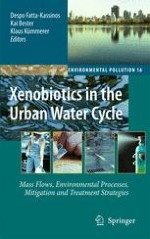2010 | OriginalPaper | Buchkapitel
18. Membrane BioReactors: A Cost-Effective Solution to Enhance the Removal of Xenobiotics from Urban Wastewaters?
verfasst von : Francesco Fatone
Erschienen in: Xenobiotics in the Urban Water Cycle
Verlag: Springer Netherlands
Aktivieren Sie unsere intelligente Suche, um passende Fachinhalte oder Patente zu finden.
Wählen Sie Textabschnitte aus um mit Künstlicher Intelligenz passenden Patente zu finden. powered by
Markieren Sie Textabschnitte, um KI-gestützt weitere passende Inhalte zu finden. powered by
